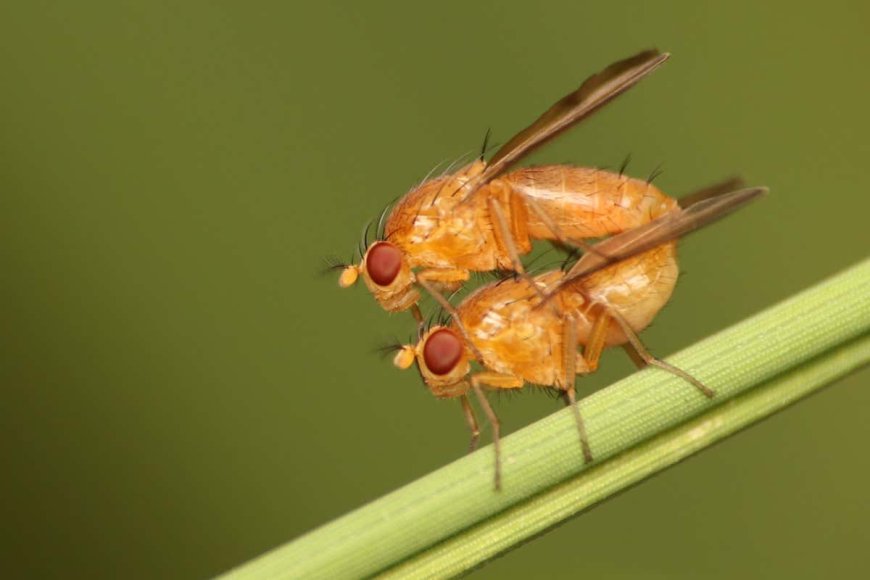Air pollution can make insects mate with the wrong species
Air pollution can make insects mate with the wrong species New Scientist

Pheromones help flies and other insects identify suitable mates

Pheromones help flies and other insects identify suitable mates
Silmiart/Shutterstock
Introduction
Some insects may struggle to find mates of the same species because increasing levels of ozone pollution are breaking down the smells released by potential partners. Ground-level ozone is a greenhouse gas that is formed when vehicle emissions react with other gases in the air. Levels of the pollutant increase in the summer because sunlight and warmth trigger more of these reactions.
Advertisement
Research Findings
Last year, Markus Knaden at the Max Planck Institute for Chemical Ecology in Germany and his colleagues found that ozone interacts with insect chemical signals called pheromones, which play a key role in mating. They found that male flies became less attractive to females as a result of elevated ozone in the air.
To follow on from that work, the team investigated if this pheromone degradation could affect flies’ ability to distinguish between different species. The researchers chose to focus on four closely related species of fruit fly: Drosophila melanogaster, Drosophila simulans, Drosophila sechellia, and Drosophila mauritiana. Males and females across these species were exposed to high levels of ozone, comparable to conditions on a hot day in a city, for 2 hours. The researchers then gave females the choice to mate with a male of either the same or a different species.
Results
- After exposure to ozone, hybrid offspring were produced around 70 per cent of the time, while the figure was just 20 per cent in a control group that was exposed to ambient air.
- The rate of mismatches was highest in D. simulans, which showed no signs of being able to tell species apart after exposure to ozone, even from visual or auditory cues.
Implications
“Hybrids are very often sterile,” says Knaden. “So flies invest a lot into their offspring, but the offspring cannot transfer their genes into future generations.” That means rising levels of surface ozone could exacerbate the devastating decline of insects around the world, he says. “There are more than 1500 insect pheromones that have been chemically described right now, and 90 per cent of them have carbon-carbon double bonds [which can be destroyed by ozone].”
Sustainable Development Goals (SDGs)
- SDG 13: Climate Action – The research highlights the impact of ozone pollution on insect populations and emphasizes the need for climate action to reduce greenhouse gas emissions.
- SDG 15: Life on Land – The decline of insects due to ozone pollution threatens biodiversity and ecosystem functioning, highlighting the importance of preserving life on land.
SDGs, Targets, and Indicators
1. Which SDGs are addressed or connected to the issues highlighted in the article?
- SDG 13: Climate Action
- SDG 15: Life on Land
The article discusses the impact of ozone pollution on insects’ ability to find mates, which is connected to climate change and the degradation of ecosystems.
2. What specific targets under those SDGs can be identified based on the article’s content?
- SDG 13.1: Strengthen resilience and adaptive capacity to climate-related hazards and natural disasters.
- SDG 13.2: Integrate climate change measures into national policies, strategies, and planning.
- SDG 15.5: Take urgent and significant action to reduce the degradation of natural habitats, halt the loss of biodiversity, and protect and prevent the extinction of threatened species.
The article highlights the need to address the impact of ozone pollution on insect mating behavior and its potential consequences for biodiversity and species survival.
3. Are there any indicators mentioned or implied in the article that can be used to measure progress towards the identified targets?
- Indicator for SDG 13.1: Number of countries with national and local disaster risk reduction strategies.
- Indicator for SDG 13.2: Number of countries that have communicated the establishment or operationalization of integrated climate change plans, strategies, or frameworks.
- Indicator for SDG 15.5: Proportion of important sites for terrestrial and freshwater biodiversity that are covered by protected areas.
The article does not explicitly mention these indicators, but they can be used to measure progress towards the identified targets. For example, tracking the number of countries with disaster risk reduction strategies or integrated climate change plans can indicate the level of resilience and adaptive capacity being built. Additionally, monitoring the proportion of important biodiversity sites covered by protected areas can assess efforts to reduce habitat degradation and protect threatened species.
SDGs, Targets, and Indicators
| SDGs | Targets | Indicators |
|---|---|---|
| SDG 13: Climate Action | 13.1: Strengthen resilience and adaptive capacity to climate-related hazards and natural disasters. 13.2: Integrate climate change measures into national policies, strategies, and planning. |
Indicator for 13.1: Number of countries with national and local disaster risk reduction strategies. Indicator for 13.2: Number of countries that have communicated the establishment or operationalization of integrated climate change plans, strategies, or frameworks. |
| SDG 15: Life on Land | 15.5: Take urgent and significant action to reduce the degradation of natural habitats, halt the loss of biodiversity, and protect and prevent the extinction of threatened species. | Indicator for 15.5: Proportion of important sites for terrestrial and freshwater biodiversity that are covered by protected areas. |
Behold! This splendid article springs forth from the wellspring of knowledge, shaped by a wondrous proprietary AI technology that delved into a vast ocean of data, illuminating the path towards the Sustainable Development Goals. Remember that all rights are reserved by SDG Investors LLC, empowering us to champion progress together.
Source: newscientist.com

Join us, as fellow seekers of change, on a transformative journey at https://sdgtalks.ai/welcome, where you can become a member and actively contribute to shaping a brighter future.







